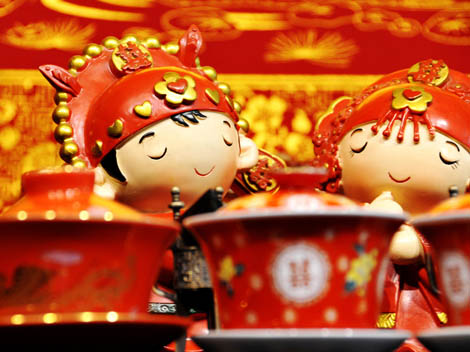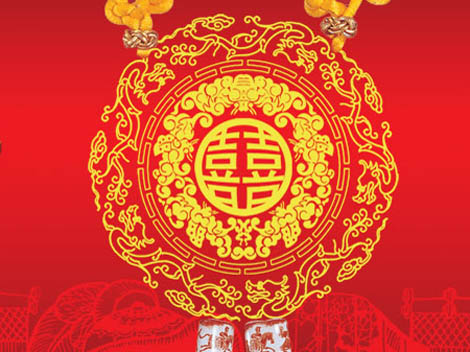Just as in the other facets of ancient Chinese life, many of the customs and rituals concerning the marriage proposal, presenting the betrothal and wedding gifts to the bride's parents, sending the bride's dowry to the future groom's family, and the wedding ceremony itself, involved the use of traditional wedding and marriage symbols.

For example, the traditional dowry would include scissors shaped like two butterflies which symbolize joy and warmth and being inseparable, vases which symbolize peace, and rulers which symbolize large fields for farming.

The dowry would have included a chamber pot filled with various fruits (symbolizing fertility) and coins (symbolizing wealth and prosperity).
The bridal bed was installed on the day before the wedding by a person with "good luck" (i.e. having many children). Auspicious symbols such as dates (meaning "soon"), peanuts (meaning "give birth"), chestnuts ("establish sons"), pomegranates (fertility), lotus seeds ("continuous births"), bran ("rich son"), and other fruits were scattered on the bridal bed. Children were then allowed to play on the bed and grab the treats.
The bride's hair was styled in the glow of "dragon and phoenix" candles representing the union of a man and a woman, and she would wear a red silk veil under a phoenix bridal crown.
The groom would wear a cap decorated with cypress leaves symbolizing the wish for "many" such as children, money, etc.
The procession from the groom's home to obtain the bride was accompanied by a dancing lion or Chinese unicorn (qilin) symbolizing good luck, prosperity, goodwill and benevolence. At the bride's home the groom would receive a pair of chopsticks which had the hidden meaning of "having sons quickly".
On the bride's journey to the groom's home, fertility symbols of rice and grain were scattered before the procession. A traditional Chinese bronze mirror would be attached to the rear of the sedan chair or to the bride's garments to protect her from evil spirits.
A bronze mirror (tongjing) and a pair of shoes (xie) were also a traditional marriage gift because the words combined formed the auspicious meaning of "together and in harmony" (tongxie).
Upon crossing the threshold of the groom's home, the bride would step over a "saddle" (an) which in Chinese has the same pronunciation as the word for "peace" (an).
At the wedding ceremony, the bride and groom would seal their marriage vows by drinking wine and honey from two cups tied together by a red cord. This reflected the belief that the "God of Marriage", also known as the "Old Man of the Moon" (yue lao , jie lin, or yue xia lao ren ), used an invisible red silk thread to tie together the feet of couples destined to be married.





